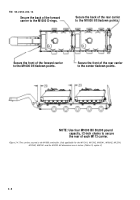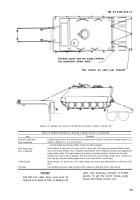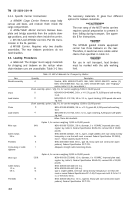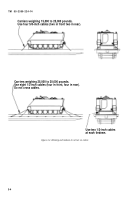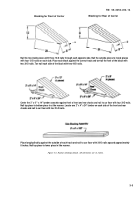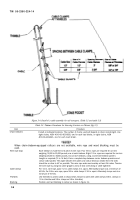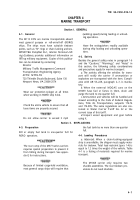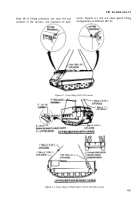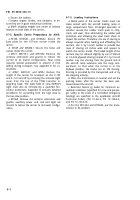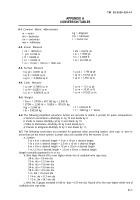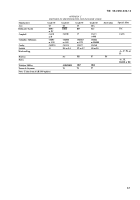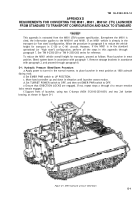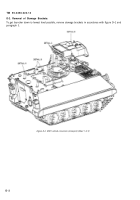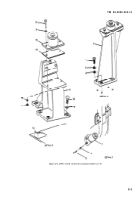TM-55-2350-224-14 - Page 40 of 57
TM 55-2350-224-14
Table 4-1. Bill of Materials for Transport by Ship
Item
Quantity
Description
Shackle Assembly
4
Shackle, NSN 4030-00-279-4475. Bolt, NSN 5305-01-006-2072. Washer (2),
NSN 5310-00-809-8541. Nut (2), NSN 5310-00-891-3428, (See “Highway”
section, table 2-3, for more details.)
Chain lashing assembly, option 1
Chain
8
NSN 4010-00-803-8858, 3/8 in. x 10 ft, grade 80, 8,250-pound safe working
load.
Load Binders
8
NSN 3990-01-213-1746, type 4 latching, 9,200-pound safe working load.
When
chain
lashing not available, option 2
wire Rope
Cable clamps (clips)
1/2 in.
5/8 in.
Thimbles
1/2 in.
Chain hoist or
come-along
About 60 ft
NSN 4010-00-272-8848, 1/2-in,, impoved plow steel, 6 x 19 IWRC or
wire-strand core, nominal BS of 23,000 pounds; Federal Specification
RR-W-410.
Type I, single-saddle wire-rope, NSN 4030-00-243-4440 (1/2-in.), NSN
16
4030-00-243-4441, (5/8-in.) (Crosby heavy-duty or meet or exceed Federal Spec-
8
ification FF-C-450 requirements).
NSN 4030-00-282-2512, type III, heavy split oval construction (open pattern),
8
Federal Specification FF-T-276.
1
Adequate strength cable tensioning device.
b. Loading.
Place the carrier in the position
For the M113A and M730A2, put the transmission
indicated by the stow plan so sufficient tiedown
in SL position.
points are available. Set the parking brakes and
c.
Tiedowns.
Table 4-2 provides instructions for
place the transmission in neutral. Disconnect the
restraining the carriers against forces encountered
battery once the carrier is positioned aboard ship.
in normal marine operations.
Table
4–2.
Tiedown Procedures for Securing a Carrier in the Hold of a General Cargo Ship
Item
Procedure
Chain tiedowns
Install at indicated locations. The number of chains used will depend on chain sizdstrength. Use
eight chains, NSN 4010-00-803-8858, two for each load binder. Cross two cables on the front and
rear of the carrier.
wire rope loops
Each tiedown is made from one piece of 1/2-in. wire rope. Length as required. Form a complete lmp
(4 required)
between carrier and ship tiedown provisions, The angle between the cables and deck (as viewed
horn the side) should be as close to 45° as possible. Cross cables on the fkont and rear of the car-
rier. The wire rope ends must overlap at least 24 inches. Tension the wire rope by using two cable
grippers and a 3-ton chain hoist or come-along.
Cable clamps
Space clamps 3 3/4 in. apart as shown. Use 1/2-in. cable clamps and alternately torque nuts to a min-
imum of 65 ft-lb.
Thimbles
Use thimbles to protect cable at sharp bends. Attach to cable with %-in. cable clamp and torque
cable clamps to a minimum of 95 ft-lb.
The methods described in this chapter for
lifting and securing vehicles are recom-
mended procedures. Other methods of
handling and stowage may be used, pro-
vided they ensure safe delivery without
damage.
To develop full cable loop working
4-5. Lifting Operations
Shiploading will often require lifting the carriers
into position aboard ship. Shipside and shoreside
cranes are usually rated in long tons (LTON),
2,240 pounds, and/or metric tons (t), 1000 kilo-
grams. To lift a carrier, a crane and sling-set
capacity of at least 13 t (12.8 LTON or 28,660
pounds) is needed.
strength, 1/2-in. cable clamp nuts must be
Crane lifting operations
torqued to at least 65 ft-lb. To ensure
dangerous. Do not stand
proper torque, apply torque in stages to
both nuts alternately.
loads.
4-2
are inherently
under overhead
Back to Top

